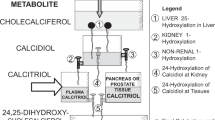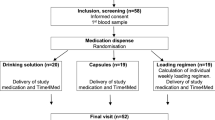Abstract
Background/Objectives:
The superiority of cholecalciferol (D3) over ergocalciferol (D2) in sustaining serum 25-hydroxy vitamin D (25OHD) levels is controversial. To compare D2 with D3 we performed a single-blind, placebo-controlled randomized trial spanning 11 weeks.
Subjects/Methods:
Healthy volunteers (n=33, aged 33.4±6 years) were divided into three groups (n=11, each): D2, D3 and placebo. Treatment started with a loading dose (100 000 IU) followed by 4800 IU/day (d) between d7 and d20 and follow-up until d77. Serum samples were obtained at baseline and at days 3, 7, 14, 21, 35, 49, 63 and 77.
Results:
Baseline 25OHD values in the D2 group were lower than those in the D3 and placebo groups (P<0.01). Placebo 25OHD levels never changed. As after the loading dose both D2 and D3 groups had reached similar 25OHD levels, we tested equivalence of the area under the concentration × time curve (AUC) between d7 and d77. The AUC was 28.6% higher for D3 compared with D2, and both were higher with respect to placebo. At d77, D2 25OHD levels were higher than those at baseline, but similar to placebo; both were lower than D3 (P<0.04). According to raw data, the elimination half-life of 25OHD was 84 and 111 days under D2 and D3 supplementation, respectively; after subtracting the placebo values, the corresponding figures were 33 and 82 days.
Conclusions:
D2 and D3 were equally effective in elevating 25OHD levels after a loading dose. In the long term, D3 seems more appropriate for sustaining 25OHD, which could be relevant for classic and non-classic effects of vitamin D.
This is a preview of subscription content, access via your institution
Access options
Subscribe to this journal
Receive 12 print issues and online access
$259.00 per year
only $21.58 per issue
Buy this article
- Purchase on Springer Link
- Instant access to full article PDF
Prices may be subject to local taxes which are calculated during checkout



Similar content being viewed by others
References
Lips P . Worldwide status of vitamin D nutrition. J Steroid Biochem Mol Biol 2010; 121: 297–300.
Mithal A, Wahl DA, Bonjour JP, Burckardt P, Dawson-Hughes B, Eisman JA et al. Global vitamin D status and determinants of hypovitaminosis D. Osteoporos Int 2009; 20: 1807–1820.
Bischoff-Ferrari HA, Giovannucci E, Willett WC, Dietrich T, Dawson-Hughes B . Estimation of optimal serum concentrations of 25-hydroxyvitamin D for multiple health outcomes. Am J Clin Nutr 2006; 84: 18–28.
Bikle D . Nonclassic actions of vitamin D. J Clin Endocrinol Metab 2009; 94: 26–34.
Trivedi DP, Doll R, Khaw KT . Effect of four monthly oral vitamin D3 (Cholecalciferol) supplementation on fractures and mortality in men and women living in the community: randomized double blind controlled trial. Br Med J 2003; 326: 469.
Mastaglia SR, Mautalen CA, Parisi MP, Oliveri B . 10.000 UI of oral vitamin D2 per day are required to rapidly reach adequate 25OHD levels in osteoporotic women. Eur J Clin Nutr 2006; 60: 1–7.
Pepper KJ, Judd SE, Nanes M, Tangpricha V . Evaluation of vitamin D repletion regimens to correct vitamin D status in adults. Endocr Pract 2009; 15: 95–103.
Bischoff-Ferrari HA, Shao A, Dawson-Hughes B, Hathcock J, Giovannucci E, Willet WC . Benefit - risk assessment of vitamin D supplementation. Osteoporos Int 2010; 7: 1121–1132.
Bikle D, Adams J, Christakos S . Vitamin D: production, metabolism, mechanism of action, and clinical requirements. In: Clifford Rosen (ed). Primer on the Metabolic Bone Diseases and Disorders of Mineral Metabolism, 7th edn. American Society for Bone and Mineral Research: Washington, DC, USA, pp 141–149, 2008.
Tjellesen L, Hummer L, Christiansen C, Rodbro P . Serum concentrations of vitamin D metabolites during treatment with vitamin D2 and D3 in normal premenopausal women. Bone Miner 1986; 1: 407–413.
Trang HM, Cole DE, Rubin LA, Pierratos A, Siu S, Vieth R . Evidence that vitamin D3 increases 25-hydroxyvitamin D more efficiently than vitamin D2. Am J Clin Nutr 1998; 68: 854–858.
Armas LA, Hollis BW, Heaney RP . Vitamin D2 is much less effective than vitamin D3 in humans. J Clin Endocrinol Metab 2004; 89: 5387–5391.
Rapuri PB, Gallagher JC, Haynatzki G . Effect of vitamin D2 and D3 supplement use on serum 25(OH)D concentration in elderly women in summer and winter. Calcif Tissue Int 2004; 74: 150–156.
Romagnoli E, Mascia ML, Cipriani C, Fassino V, Mazzei F, D́Erasmo E et al. Short and long term variations in serum calciotropic hormones after a single very large dose of ergocalciferol (vitamin D2) or cholecalciferol (vitamin D3) in the elderly. J Clin Endocrinol Metab 2008; 93: 3015–3020.
Holick MF, Biancuzzo RM, Chen TC, Klein EK, Young A, Bibuld D et al. Vitamin D2 is as effective as vitamin D3 in mantaining circulating concentrations of 25-hydroxyvitamin D. J Clin Endocrinol Metab 2008; 93: 677–681.
Leventis P, Kiely PD . The tolerability and biochemical effects of high dose bolus vitamin D2 and D3 supplementation in patients with vitamin D insufficiency. Scand J Rheumatol 2009; 38: 149–153.
Glendenning P, Chew GT, Seymour HM, Guillet MJ, Goldsain PR, Inderjeeth CA et al. Serum 25 hydroxyvitamin D levels in vitamin D- insufficient hip fracture patients after supplementation with ergocalciferol and cholecalciferol. Bone 2009; 45: 870–875.
Biancuzzo RM, Young A, Bibuld D, Cai MH, Winter MR, Klein EK et al. Fortification of orange juice with vitamin D2 or vitamin D3 is as effective as an oral supplement in maintaining vitamin D status in adults. Am J Clin Nutr 2010; 91: 1621–1626.
Heaney RP, Recker RR, Grote J, Horst RL, Armas LAG . Vitamin D3 is more potent than vitamin D2 in humans. J Clin Endocrinol Metab 2011; 96: E447–E442.
Binkley N, Gemar D, Engelke J, Gangnon R, Ramamurthy R, Krueger D et al. Evaluation of ergocalciferol or cholecalciferol dosing, 1600UI daily or 50000IU monthly in older adults. J Clin Endocrinol Metab 2011; 96: 981–988.
Seijo M, Mastaglia SR, Brito G, Somoza J, Oliveri B . ¿Es equivalente la suplementación diaria con vitamina D2 o vitamina D3 en adultos mayores? Medicina 2012; 72: 195–200.
Vieth R, Chan PCR, Mac Fairline GD . Efficacy and safety of vitamin D3 intake exceeding the lowest observed adverse effect levels. Am J Clin Nutr 2001; 73: 288–294.
Brito GM, Mastaglia SR, Goedelman C, Seijo M, Somoza J, Oliveri B . Estudio exploratorio de la ingesta y prevalencia de vitamina D en mujeres mayores de 65 años que viven en hogar familiar o en residencias para autoválidos de la Ciudad de Buenos Aires. Nutrición Hospitalaria 2013; 28: 816–822.
IOM Dietary Reference Intake for calcium and vitamin D. The National Academies Press: Washington DC, 2011.
Bouillon R, Van Schoor NM, Gielen E, Boonen S, Mathieu C, Vanderschueren D et al. Optimal vitamin D status: a critical analysis on the basis of evidence-based medicine. J Clin Endocrinol Metab 2013; 98: E1283–E1304.
Holick MF, Binkley NC, Bischoff-Ferrari HA, Gordon CM, Hanley DA, Heaney RP et al. Evaluation, treatment, and prevention of vitamin D deficiency: an endocrine society clinical practice guideline. J Clin Endocrinol Metab 2011; 96: 1911–1930.
Hsuan FC . Estimating treatment means in a mixed-effect ANOVA model for bioequivalence studies. Biometrics1993 49: 703–713.
Chow SC, Liu JP . Design and analysis of bioavailability and bioequivalence studies. 2nd edn. Marcel Dekker: New York, NY, USA, 2000.
Anderson S, Hauck WW . A new procedure for testing equivalence in comparative bioavailability and other clinical trials. Comm Statist Theory Methods 1983; 12: 2663–2692.
Schuirmann DJ . A comparison of the two one-sided tests procedure and the power approach for assessing the equivalence of average bioavailability. J Pharmacokinet Biopharm 1987; 15: 657–680.
US Food and Drug Administration Guidance for Industry. Statistical approaches to establishing bioequivalence. http://www.fda.gov/downloads/Drugs/GuidanceComplianceRegulatoryInformation/Guidances/ucm070244.pdf. Last accessed on 15 October 2013.
Wacker M, Holick FH . Vitamin D. Effects on skeletal and extraskeletal health and the need for supplementation. Nutrients 2013; 5: 111–148.
Tripkovic L, Lambert H, Hart K, Smith CP, Bucca G, Penson S et al. Comparison of vitamin D2 and vitamin D3 supplementation in raising serum 25-hydroxyvitamin D status: a systematic review and meta-analysis. Am J Clin Nutr 2012; 95: 1357–1364.
Ladizesky M, Oliveri B, Mautalen CA . Niveles séricos de 25-hidroxivitamina D en la población normal de Buenos Aires, su variación estacional. Medicina 1987; 47: 268–272.
Ladizesky M, Lu Z, Oliveri MB, San Román N, Holick M, Mautalen CA . Solar ultraviolet - B radiation and photoproduction of vitamin D in Central and Southern areas of Argentina. J Bone Min Res 1995; 10: 545–549.
Heaney RP, Davies KM, Chen TC, Holick MF, Barger-Lux MJ . Human serum 25-hydroxycholecalciferol response to extended oral dosing with cholecalciferol. Am J Clin Nutr 2003; 77: 204–210.
Hollis BW . Comparison of equilibrium and disequilibrium assay conditions for ergocalciferol, cholecalciferol and their major metabolites. J Steroid Biochem 1984; 12: 81–86.
Nimitphong H, Saetung S, Chanprasertyotin S, Chailurkit LO, Ongphiphadhanakul B . Changes in circulating 25-hydroxyvitamin D according to vitamin D binding protein genotypes after vitamin D3 or D2 supplementation. Nutr J 2013; 12: 39.
Nilsson SF, Ostberg L, Peterson PA . Binding of vitamin D to its human carrier plasma protein 1972. Biochem Byophys Res Commun 1972; 46: 1380–1387b.
Schuster I . Cytochromes P450 are essential players in the vitamin D signaling system. Biochim Biophys Acta 2011; 1814: 186–199.
Spedding S, Vanlint S, Morris H, Seragg R . Does vitamin D sufficiency equate to a single serum 25-hydroxyvitamin D level or are different levels required for non-skeletal diseases? Nutrients 2013; 5: 5127–5139.
Hollis BW, Wagner C . The role of the parent compound vitamin D with respect to metabolism and function: why clinical dose intervals can affect clinical outcomes. J Clin Endocr Metab 2013; 98: 4619–4628.
Acknowledgements
BO and SRM are members of the research career of CONICET (Argentina's National Research Council); JS is a member of support career of CONICET. We are indebted to the pharmaceutical companies Roemmers, Spedrog Caillon and Gador, which supplied the vials of Vitamin D2, Vitamin D3 and calcium, respectively. This research received financial support from grant PICT # 523 of Argentina's National Agency for the Promotion of Science and Technology (ANPCyT).
Author information
Authors and Affiliations
Corresponding author
Ethics declarations
Competing interests
The authors declare no conflict of interest.
Rights and permissions
About this article
Cite this article
Oliveri, B., Mastaglia, S., Brito, G. et al. Vitamin D3 seems more appropriate than D2 to sustain adequate levels of 25OHD: a pharmacokinetic approach. Eur J Clin Nutr 69, 697–702 (2015). https://doi.org/10.1038/ejcn.2015.16
Received:
Revised:
Accepted:
Published:
Issue Date:
DOI: https://doi.org/10.1038/ejcn.2015.16
This article is cited by
-
Maternal plasma vitamin D levels across pregnancy are not associated with neonatal birthweight: findings from an Australian cohort study of low-risk pregnant women
BMC Pregnancy and Childbirth (2023)
-
Assessing the impact of a mushroom-derived food ingredient on vitamin D levels in healthy volunteers
Journal of the International Society of Sports Nutrition (2020)
-
CYP27A1, CYP24A1, and RXR-α Polymorphisms, Vitamin D, and Multiple Sclerosis: a Pilot Study
Journal of Molecular Neuroscience (2018)
-
Model-based meta-analysis for comparing Vitamin D2 and D3 parent-metabolite pharmacokinetics
Journal of Pharmacokinetics and Pharmacodynamics (2017)
-
The vitamin D deficiency pandemic: Approaches for diagnosis, treatment and prevention
Reviews in Endocrine and Metabolic Disorders (2017)



